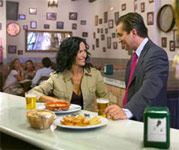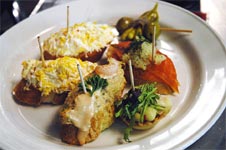LAS TAPAS
 In
Spain when you ask for a beer in a bar, it isn't unusual to have
a small plate of food, or 'tapa', to go with it. Tapas are often
eaten standing up, and they could be a simple plate of olives or
salted almonds, or maybe something a little more elaborate.
These tasty dishes are usually enjoyed with friends before lunch
or dinner and they go nicely with a cold beer or a glass of
wine. You'll probably see these dishes on display at the bar,
and to order them just ask for 'una racion' (a portion)
of the tapa that most takes your fancy.
In
Spain when you ask for a beer in a bar, it isn't unusual to have
a small plate of food, or 'tapa', to go with it. Tapas are often
eaten standing up, and they could be a simple plate of olives or
salted almonds, or maybe something a little more elaborate.
These tasty dishes are usually enjoyed with friends before lunch
or dinner and they go nicely with a cold beer or a glass of
wine. You'll probably see these dishes on display at the bar,
and to order them just ask for 'una racion' (a portion)
of the tapa that most takes your fancy.
 La
tortilla de patatas (potato omelette), las patatas bravas (potatoes
with spicy sauce), los boquerones en vinagre (anchovies in
vinegar, los pimientos rellenos (stuffed peppers), and a
thousand and one other top quality dishes from the Spanish
kitchen, can all be enjoyed with some bread (pan) and an
ice cold beer in the summer heat.
La
tortilla de patatas (potato omelette), las patatas bravas (potatoes
with spicy sauce), los boquerones en vinagre (anchovies in
vinegar, los pimientos rellenos (stuffed peppers), and a
thousand and one other top quality dishes from the Spanish
kitchen, can all be enjoyed with some bread (pan) and an
ice cold beer in the summer heat.
And in amongst these delicacies, you'll also be able to find
what is arguably the best ham in the world;
el jamón de "pata negra" from the Iberican pig, raised
in the wild and fed on acorns. But a word of warning; if you ask
for ham in Spain, don't expect to get boiled ham (which the
Spanish call "jamón york", York ham) but
instead you'll get a deliciously tasty cured product that you
won't be able to stop eating in any Spanish bar or restaurant.